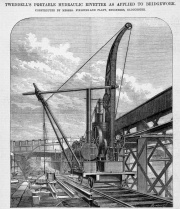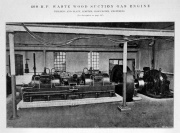Fielding and Platt







































































Fielding and Platt, hydraulic engineers, of Atlas Ironworks, Gloucester.
formerly Samuel Fielding was in partnership with John Gillett at the Atlas Ironworks
1866 Company founded by Samuel Fielding and James Platt.
1870 Made a machine for hydraulically testing pipes from 3" to 24" diameter and up to 9 ft long, for Vienna Water Works. The arrangement resembled that of a lathe, having a headstock and tailstock on a bed, with two 'faceplates' having circumferential grooves to locate and seal the pipe ends (using rubber gaskets). A hand pump supplied the pressure through the 'headstock'. Inside the pipe, an adjustable tube and valve were provided for releasing the air from the top of the pipe.[1]
1871 Sole manufacture of Tweddell's hydraulic riveting machines,
1873 Made the first hydraulic portable riveting machinery for the Primrose Street Railway Bridge of the Great Eastern Railway at Bishopsgate Street Station, London, which proved a great success.
1875 Maker of Tweddell's hydraulic rivetter
1880 Produced their first gas engine with sizes from 3hp to 8hp
1881 Produced the Uniflow engine
1884 Rope-driven overhead crane produced [2]
1885 Illustrated description of Fielding & Platt's high speed engine. The engines were to be made in thirteen sizes, the cylinders varying in diameter from 2 in. to 8 in. Cutting off at half stroke, and running at 1000 rpm with 100 lb. pressure of steam, the indicated power would range from 4 to 516 horsepower. [3]. See illustration.
1886 Description and illustrations of duplex pumping engine [4]
1886 Engravings of hydraulic veeing presses for 'glutting' spokes on railway wheels, as sipplied to Pearson and Knowles Coal and Iron Co and Krupp of Essen. [5]
1889 Paris Exhibition. Hydraulic plant. [6]
1891 Description and illustrations of gas engine rated at 16 HP but capable of 42 IHP.[7]
1892 Crystal Palace Electrical Exhibition. 8-hp and 14-hp horizontal gas engine based on Otto principle. [8]
1894 Coupled Horizontal Tandem Pumping Engines for Castle Eden Colliery. Article and illustrations in 'The Engineer'. [9]
1894 June. Took part in the Royal Agricultural Society’s Competitive Trial of Oil Engines. 8.0 bhp fixed engine and a portable engine. Article in ‘The Engineer’. [10]
1894 Antwerp Exhibition. Awarded Gold Medal for Large Mechanical Constructions.
1895 Private company.
1895 After the death of Mr. Tweddell the company took over all the rights connected with his hydraulic machinery.
1897 Employ 500 persons.[11]
1898 Introduced a lampless oil engine
c1901 Produced the prototype mechanically-powered vacuum cleaner for Hubert Cecil Booth
1908 Producing the Safety oil engine in sizes up to 60 bhp (single) and 120 bhp (twin)
1908 Gas engines and gas producers
1911 Manufacturer of Flanging Presses (Tweddell's System); Forging Presses; Hydraulic Machinery for the Railways.[12]
1911 Gun-straightening machine for Italy. [13]
1911 Smithfield Club Show. Exhibited gas and oil engines plus a suction gas plant and a combined engine and pump. [14].
1912 A low-pressure heavy oil engine introduced
c1928 A range of vertical high-speed engine introduced producing 50 hp (twin), 100 hp (four) and 150 hp (six cylinder) versions
1937/8 The company was taken over by Brush; the engines part was merged with Petters
1939 Heenan and Froude acquired the remaining assets of Fielding and Platt[15], essentially the hydraulics business.
1955-7 Constructed a large upstroke press for Whessoe, with a maximum force of 4500 tons, to form steel plates for spherical pressure vessels, the first application being at the Dounreay Atomic Energy Establishment. Described in The Engineer, 31 January 1958[16]. See also here[17] for links to various articles and illustrations, including a film about the design and installation.
1961 Engineers, specialising in hydraulic machinery, presses, pumps and accumulators. 620 employees. [18]
1965 Supplied high-energy rate drop forging machines (the first in Britain) made under licence from General Dynamics of USA[19]
1968 Hydraulic extrusion press for the UKAEA. [20]
1968 Formation of Redman Heenan International.
1978 Sole UK licence holder for USI-Clearing of Chicago, the largest manufacturer of metal and plastic forming processes in the world[21].
1982 Disposal of Fielding and Platt by Redman Heenan International anticipated[22].
1986 Fielding & Platt enters voluntary receivership. Clayton, Son & Co. (Holdings) Ltd. bought the company from the Receivers.
1994 Motherwell Bridge Group took over the Clayton Group.
1999 Fielding & Platt name dropped in favour of MB Material Handling Systems incorporting MB Nuclear and FPI (MB = Motherwell Bridge).
2000 End of manufacturing at Gloucester. An office was retained.
2003 Acquired by Group Rhodes
2003 Gloucester office closed.
See Also
Sources of Information
- ↑ [1] Engineering, 2 Dec 1870
- ↑ Engineering 13th June 1884 p523
- ↑ Engineering 1885/07/31 pp.104-5
- ↑ Engineering 1886/08/13
- ↑ Engineering 1886/12/10
- ↑ The Engineer of 10th May 1889 p396
- ↑ Engineering 1891/07/31
- ↑ 1892 The Practical Engineer
- ↑ The Engineer of 9th March 1894 p194-5 & p197
- ↑ The Engineer of 22nd June 1894 p540
- ↑ Gloucester Journal - Saturday 27 February 1897
- ↑ Bradshaw’s Railway Manual 1911
- ↑ The Engineer 1911/08/25 p213
- ↑ The Engineer 1911/12/08 p594
- ↑ The Times, 23 November 1939
- ↑ [2] Extract from The Engineer, 31 January 1958
- ↑ [3] Fielding & Platt history website: The Whessoe Story
- ↑ 1961 Dun and Bradstreet KBE
- ↑ The Times, Dec 01, 1965
- ↑ The Engineer of 5th January 1968 p10
- ↑ The Times, 17 April 1978
- ↑ The Times, 16 December 1982
- The Engineer of 6th July 1894 p9 & p25
- The Engineer of 2nd November 1894 p387

